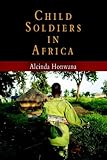Child Soldiers in Africa / Alcinda Honwana.
Material type: TextSeries: The Ethnography of Political ViolencePublisher: Philadelphia : University of Pennsylvania Press, [2011]Copyright date: ©2006Description: 1 online resource (216 p.) : 2 illusContent type:
TextSeries: The Ethnography of Political ViolencePublisher: Philadelphia : University of Pennsylvania Press, [2011]Copyright date: ©2006Description: 1 online resource (216 p.) : 2 illusContent type: - 9780812219876
- 9780812204773
- 355.0083096
- online - DeGruyter
- Issued also in print.
| Item type | Current library | Call number | URL | Status | Notes | Barcode | |
|---|---|---|---|---|---|---|---|
 eBook
eBook
|
Biblioteca "Angelicum" Pont. Univ. S.Tommaso d'Aquino Nuvola online | online - DeGruyter (Browse shelf(Opens below)) | Online access | Not for loan (Accesso limitato) | Accesso per gli utenti autorizzati / Access for authorized users | (dgr)9780812204773 |
Browsing Biblioteca "Angelicum" Pont. Univ. S.Tommaso d'Aquino shelves, Shelving location: Nuvola online Close shelf browser (Hides shelf browser)

|

|

|

|

|

|

|
||
| online - DeGruyter Gandhi's Body : Sex, Diet, and the Politics of Nationalism / | online - DeGruyter Knowing Dil Das : Stories of a Himalayan Hunter / | online - DeGruyter Karaoke Fascism : Burma and the Politics of Fear / | online - DeGruyter Child Soldiers in Africa / | online - DeGruyter Economic Rights in Canada and the United States / | online - DeGruyter The Kingdom of Sicily, 1100-1250 : A Literary History / | online - DeGruyter The Story of the Negro / |
Frontmatter -- Contents -- Introduction -- 1. Civil Wars in Mozambique and Angola -- 2. Historical and Social Contexts -- 3. Recruitment and Initiation -- 4. Young Women -- 5. Healing Child Soldiers and Their Communities -- 6. Looking to the Future and Learning from the Past -- Notes -- Index -- Acknowledgments
restricted access online access with authorization star
http://purl.org/coar/access_right/c_16ec
Young people have been at the forefront of political conflict in many parts of the world, even when it has turned violent. In some of those situations, for a variety of reasons, including coercion, poverty, or the seductive nature of violence, children become killers before they are able to grasp the fundamentals of morality. It has been only in the past ten years that this component of warfare has captured the attention of the world. Images of boys carrying guns and ammunition are now commonplace as they flash across television screens and appear on the front pages of newspapers. Less often, but equally disturbingly, stories of girls pressed into the service of militias surface in the media.A major concern today is how to reverse the damage done to the thousands of children who have become not only victims but also agents of wartime atrocities. In Child Soldiers in Africa, Alcinda Honwana draws on her firsthand experience with children of Angola and Mozambique, as well as her study of the phenomenon for the United Nations and the Social Science Research Council, to shed light on how children are recruited, what they encounter, and how they come to terms with what they have done. Honwana looks at the role of local communities in healing and rebuilding the lives of these children. She also examines the efforts undertaken by international organizations to support these wartime casualties and enlightens the reader on the obstacles faced by such organizations.
Issued also in print.
Mode of access: Internet via World Wide Web.
In English.
Description based on online resource; title from PDF title page (publisher's Web site, viewed 24. Apr 2022)


